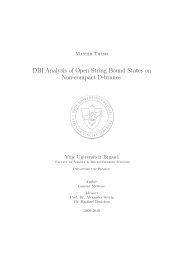Mismatch and synchronization: Influence of asymmetries in ... - CSIC
Mismatch and synchronization: Influence of asymmetries in ... - CSIC
Mismatch and synchronization: Influence of asymmetries in ... - CSIC
You also want an ePaper? Increase the reach of your titles
YUMPU automatically turns print PDFs into web optimized ePapers that Google loves.
MISMATCH AND SYNCHRONIZATION: INFLUENCE OF ... PHYSICAL REVIEW E 83, 056211 (2011)FIG. 14. (Color onl<strong>in</strong>e) Cross-correlation <strong>of</strong> the field <strong>in</strong>tensitiesvs K <strong>and</strong> L with <strong>and</strong> without delay mismatch. (a) Symmetric delays:τ = 0, zero-lag <strong>synchronization</strong>; (b) with delay mismatch τ =20, cross-correlation at t = τ. The nonl<strong>in</strong>ear ga<strong>in</strong> saturation isignored for these simulations. Parameters: μ = 0, p = 1.0, α = 4.0,T = 200, τ = 1000, <strong>and</strong> noise β = 10 −5 .de<strong>synchronization</strong> events or do not synchronize at all. TheL − K plots <strong>in</strong> Fig. 14 show therefore significantly smaller areas<strong>of</strong> high <strong>synchronization</strong> for μ = 0 than the correspond<strong>in</strong>gplots for μ = 0.26 (Figs. 2 <strong>and</strong> 9).VI. CONCLUSIONSWe have numerically <strong>and</strong> analytically <strong>in</strong>vestigated thedynamical <strong>and</strong> <strong>synchronization</strong> properties <strong>of</strong> a system <strong>of</strong>two delay-coupled semiconductor lasers <strong>in</strong> different coupl<strong>in</strong>gschemes. Us<strong>in</strong>g a model for a setup <strong>of</strong> two lasers coupledvia a semitransparent mirror, we have studied the <strong>in</strong>fluence<strong>of</strong> a mismatch between the transmission <strong>and</strong> reflection <strong>of</strong>the mirror, i.e., a mismatch between coupl<strong>in</strong>g <strong>and</strong> feedbackstrength, as well as a delay mismatch correspond<strong>in</strong>g to amisalignment <strong>of</strong> the mirror from the middle.We showed that a coupl<strong>in</strong>g mismatch deteriorates thestability <strong>of</strong> the synchronized solution, but does not change thesynchronized dynamics. In both the LFF regime <strong>and</strong> the CCregime, a larger mismatch results <strong>in</strong> longer bubbl<strong>in</strong>g events,s<strong>in</strong>ce less modes are transversely stable. However, we stillobserve high-level <strong>synchronization</strong> if the mismatch |L − K|rema<strong>in</strong>s small. The cross-correlation (at zero lag) <strong>of</strong> the twolasers does not depend on the sign <strong>of</strong> the mismatch betweencoupl<strong>in</strong>g <strong>and</strong> feedback L − K, but only on the absolute value.The <strong>in</strong>clusion <strong>of</strong> a saturable nonl<strong>in</strong>ear ga<strong>in</strong> leads not only toa reduction <strong>of</strong> complexity <strong>in</strong> the time series but also to a broaderdoma<strong>in</strong> <strong>of</strong> high <strong>synchronization</strong> quality, s<strong>in</strong>ce it <strong>in</strong>creases thetransverse stability <strong>of</strong> the ECMs.Our analysis has shown that the <strong>synchronization</strong> properties<strong>of</strong> a configuration with a semitransparent mirror are the sameas those <strong>of</strong> a drive-response configuration, at least on thelevel <strong>of</strong> the ECMs. An open-loop configuration synchronizesbest; the transverse stability <strong>of</strong> the modes is the same as<strong>in</strong> a configuration without coupl<strong>in</strong>g mismatch. Add<strong>in</strong>gself-feedback to the receiver has the same effect on stabilityas <strong>in</strong>troduc<strong>in</strong>g a coupl<strong>in</strong>g mismatch <strong>in</strong> the relay setup.If there is a delay mismatch, we found that the laserscan synchronize with a nonzero lag. The time traces thenexhibit a relative time shift proportional to the misalignment<strong>of</strong> the mirror. The stability <strong>of</strong> the time-shifted identical<strong>synchronization</strong> <strong>of</strong> the lasers is not much affected by the value<strong>of</strong> the delay mismatch. The dynamics, however, undergoesdrastic changes for vary<strong>in</strong>g τ, as the alignment <strong>of</strong> theexternal cavity modes is altered compared to symmetricdelays.Especially for very small mismatch, for rational ratios<strong>of</strong> the respective delay times, <strong>and</strong> if the second delay isvery short compared to the first one, the chaotic dynamicscan be suppressed <strong>and</strong> stabilized toward either s<strong>in</strong>gle modeoutput or periodic behavior. These qualitative features do notdepend on the delay time, but merely on the delay mismatch<strong>and</strong> relative ratios <strong>of</strong> delay times. They were found robust forbroad ranges <strong>of</strong> the coupl<strong>in</strong>g strengths (i.e., the transmission<strong>and</strong> reflection <strong>of</strong> the relay mirror) <strong>and</strong> even for high noiselevels. We conjecture that they are caused by destructive<strong>in</strong>terference.We also found that a delay mismatch makes the systemmuch more sensitive to a coupl<strong>in</strong>g mismatch. The correlationbetween the two laser outputs decreases much more rapidlywith <strong>in</strong>creas<strong>in</strong>g coupl<strong>in</strong>g mismatch than for the case <strong>of</strong>symmetric delays.Our results are <strong>of</strong> high practical value for future(experimental) <strong>in</strong>vestigations consider<strong>in</strong>g delay-coupledlasers. The ability to target specific stability regions viamismatch adjustments can, for example, be helpful for chaoscommunication systems or r<strong>and</strong>om number generation. In addition,due to the broad <strong>in</strong>terest <strong>in</strong> <strong>synchronization</strong> phenomenathroughout the scientific community, our results concern notonly the immediate applications to chaotic communication,but may also be relevant to scientists <strong>in</strong> related fields suchas computational neuroscience, eng<strong>in</strong>eer<strong>in</strong>g, <strong>and</strong> biology.The presented analytical results can be transferred to otherdelay-coupled systems with correspond<strong>in</strong>g network topology<strong>and</strong> therefore could f<strong>in</strong>d applications, e.g., <strong>in</strong> electro-optic orneuronal systems.ACKNOWLEDGMENTSO.D. acknowledges the Research Foundation Fl<strong>and</strong>ers(FWO-Vla<strong>and</strong>eren) for support. This research was partiallysupported by MICINN (Spa<strong>in</strong>) under project DeCoDicA(Project No. TEC2009-14101), by DFG (Germany) <strong>in</strong> theframework <strong>of</strong> SFB 910, by the Interuniversity AttractionPoles program <strong>of</strong> the Belgian Science Policy Office, underGrant No. IAP VI-10 (photonics@be), <strong>and</strong> by the projectPHOCUS. The project PHOCUS, <strong>in</strong> turn, acknowledges thef<strong>in</strong>ancial support <strong>of</strong> the Future <strong>and</strong> Emerg<strong>in</strong>g Technologies(FET) program with<strong>in</strong> the Seventh Framework Programmefor Research <strong>of</strong> the European Commission, under FET-OpenGrant No. 240763.APPENDIX : STABILITY CALCULATION FOR CAVITYMODESAn external cavity mode (ECM) <strong>of</strong> the Lang-Kobayashiequations is a steady-state solution <strong>of</strong> the form E j = Ae iωt<strong>and</strong> n j = n. To calculate its (transverse) stability, we make thetransformation E j → Ee −iωt such that the ECM becomes asteady state, <strong>and</strong> split the electric field <strong>in</strong>to a real <strong>and</strong> imag<strong>in</strong>arypart E = A = x + iy. With this, we calculate the JacobianDf (S) with trajectory S correspond<strong>in</strong>g to the transformedECM solution. We then determ<strong>in</strong>e the eigenvalues <strong>of</strong> the056211-9
















